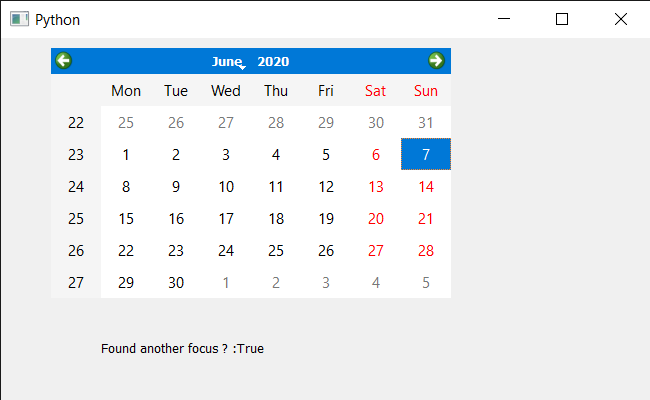En este artículo veremos cómo podemos hacer el foco a cualquier otro widget de QCalendarWidget. Para hacer esto usamos el focusNextPrevChildmétodo. Encuentra un nuevo widget para enfocar el teclado, según corresponda para Tabulador y Shift+Tab, y devuelve verdadero si puede encontrar un nuevo widget, o falso si no puede.
Para hacer esto, usaremos
focusNextPrevChildel método con el objeto QCalendarWidget.Sintaxis: calendar.focusNextPrevChild(siguiente)
Argumento: Toma bool como argumento, si next es verdadero, esta función busca hacia adelante, si next es falso, busca hacia atrás.
Return : Devuelve bool
A continuación se muestra la implementación.
Python3
# importing libraries
from PyQt5.QtWidgets import *
from PyQt5 import QtCore, QtGui
from PyQt5.QtGui import *
from PyQt5.QtCore import *
import sys
class Window(QMainWindow):
def __init__(self):
super().__init__()
# setting title
self.setWindowTitle("Python ")
# setting geometry
self.setGeometry(100, 100, 650, 400)
# calling method
self.UiComponents()
# showing all the widgets
self.show()
# method for components
def UiComponents(self):
# creating a QCalendarWidget object
self.calender = QCalendarWidget(self)
# setting geometry to the calendar
self.calender.setGeometry(50, 10, 400, 250)
# setting cursor
self.calender.setCursor(Qt.PointingHandCursor)
# creating label to show the properties
self.label = QLabel(self)
# setting geometry to the label
self.label.setGeometry(100, 280, 250, 60)
# making label multi line
self.label.setWordWrap(True)
# focus on previous child
value = self.calender.focusNextPrevChild(False)
# setting text to the label
self.label.setText("Found another focus ? :" + str(value))
# create pyqt5 app
App = QApplication(sys.argv)
# create the instance of our Window
window = Window()
# start the app
sys.exit(App.exec())
Producción :
Publicación traducida automáticamente
Artículo escrito por rakshitarora y traducido por Barcelona Geeks. The original can be accessed here. Licence: CCBY-SA